Scenery, Health Benefits, Accommodations, Food:A thorough explanation of the charms of Ginzan Onsen in Yamagata Prefecture
The Ginzan Onsen region of Yamagata has many attractions, such as photogenic townscapes with nostalgic glimpses of Taisho-era culture, hot springs with many health benefits, and spectacular natural landscapes. Read on to find out how to discover them all.
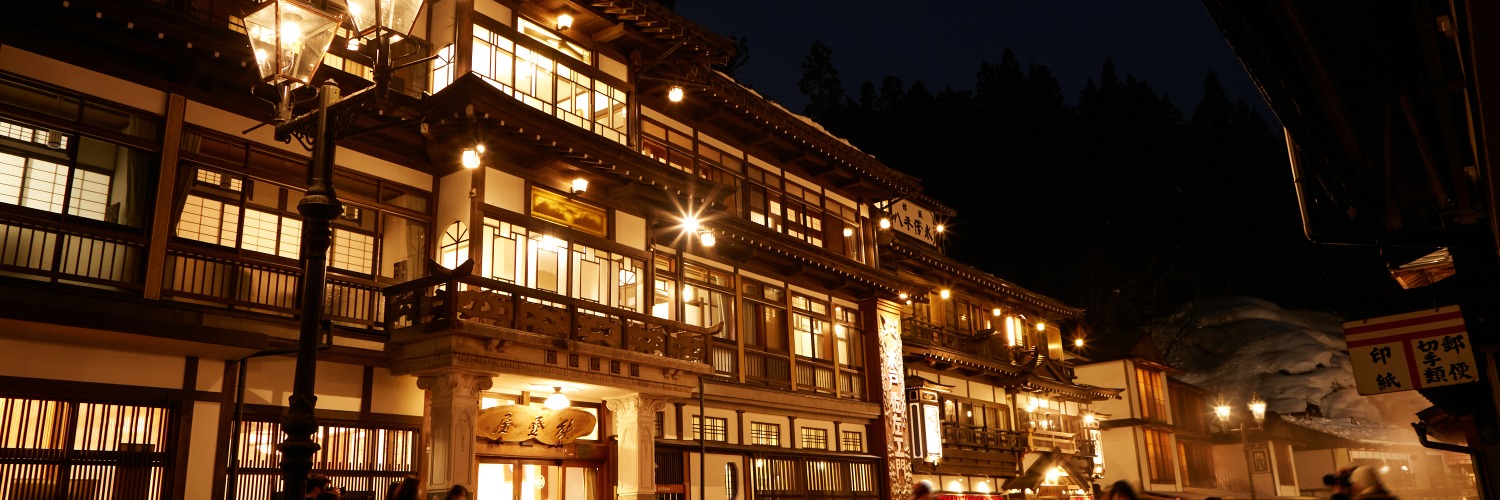
1. Enter a nostalgic and bizarre world
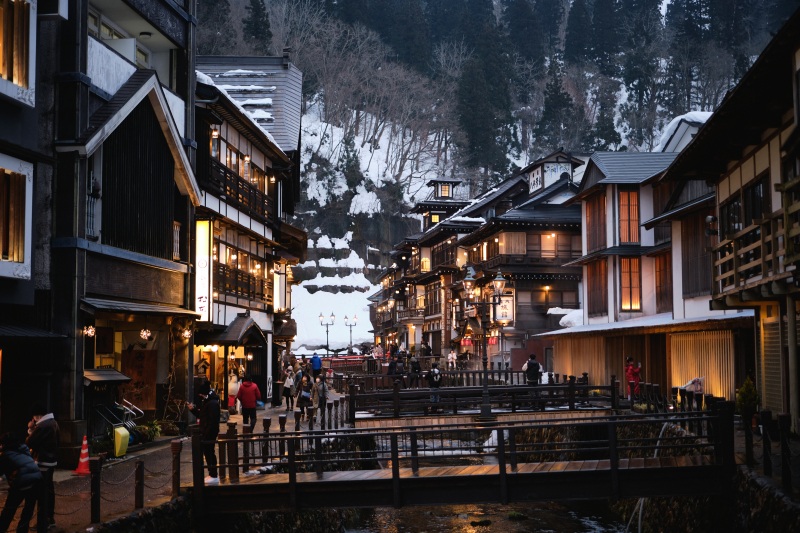
Surrounded by lush mountains, the Ginzan Onsen area in Yamagata (Northeast Japan) offers ultimate relaxation and an escape from the hustle and bustle of city life. The riverfront is home to a famous hot spring district composed of wooden ryokan inns built between the Taisho era and the beginning of the Showa era (1912–the 1920s), creating a nostalgic townscape with a certain old-world charm.
The well-established hot spring resort prospered as a silver mine during the Edo period and has healed countless tourists for more than 400 years. It later became famous as one of the filming locations of "Oshin," Japan's most-watched TV series of all time. As soon as you step foot in Ginzan, you will be welcomed by the pleasant sound of flowing water in the Ginzan River and the sight of steam rising from the foot baths along the streets, a scenery you can only see at thermal resorts. Strolling through the town that retains the old charms of the Taisho era will take you back in time, a surreal and fascinating experience.
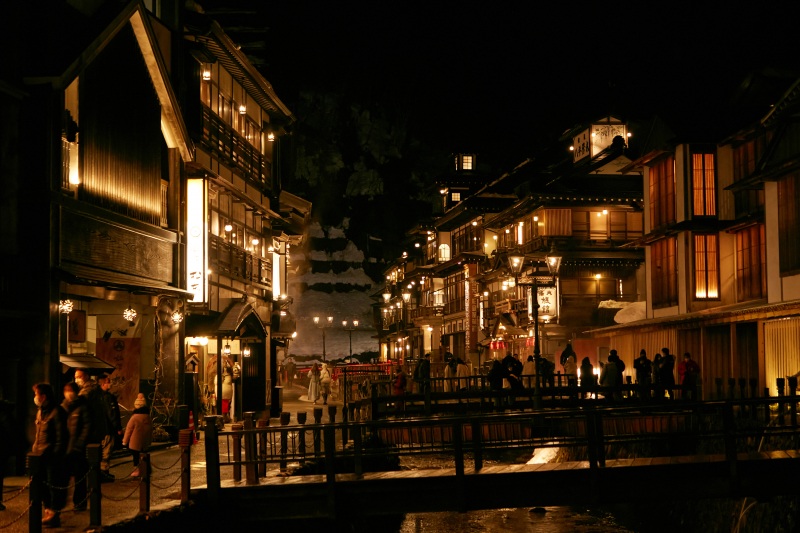
Vastly distinct in all four seasons and even between day and nighttime, every corner of Ginzan Onsen is excellent for panoramic photos. As the sun sets in the evening, gas lamps light up the town in its warmth, creating an atmosphere that can't be experienced in a metropolis. The townscape is captivating in every season, with a dynamic natural beauty such as fresh greenery in the spring and summer, autumn foliage in the fall season, and breathtaking snowscapes in winter. Winter is by far the most popular season to visit Ginzan. Watching the pillowy snow pile atop the rugged mountains is so enchanting you'd think that time had stopped. The spectacular snowscape is at its best when lit up at night, transforming it into a romantic scenery you will surely remember forever.
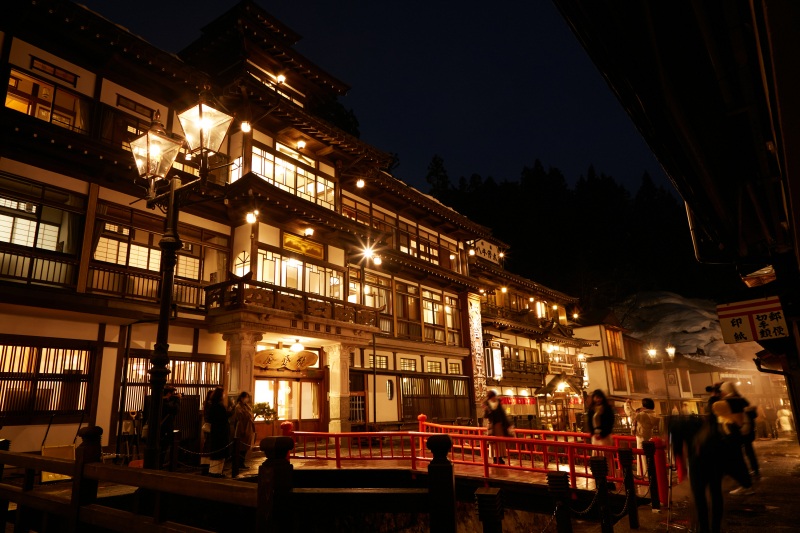
Notoya Ryokan is a long-established inn that has charmed many visitors for ages and has become a permanent fixture of the town's scenery. The three-story wooden structure was completed in 1921 and has been designated as a tangible cultural property of Japan, befitting its majestic appearance. At the entrance is a "kote-e" or relief of the founder's name, which boldly welcomes guests.
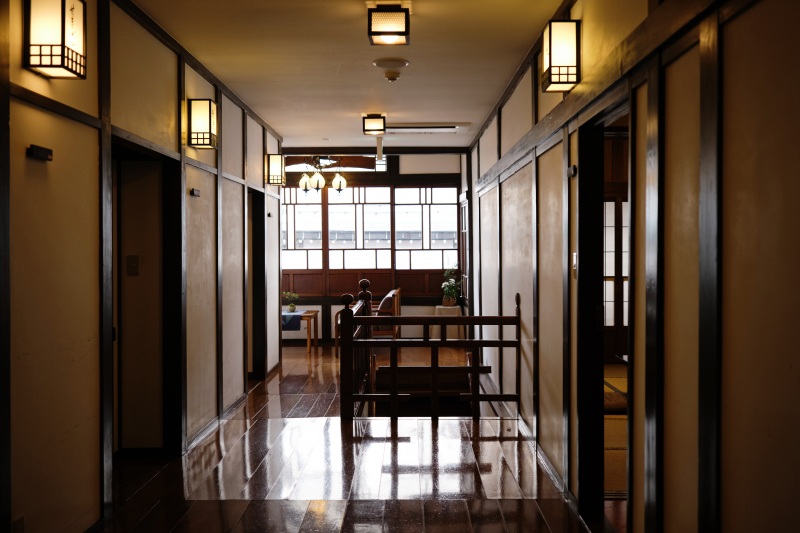
The interior is well maintained with stairs that have remained since its construction and antique furnishings that tell a tale of the past. The Japanese-style rooms feature relaxing views of the river, with detailed wood engravings adding a soothing touch.
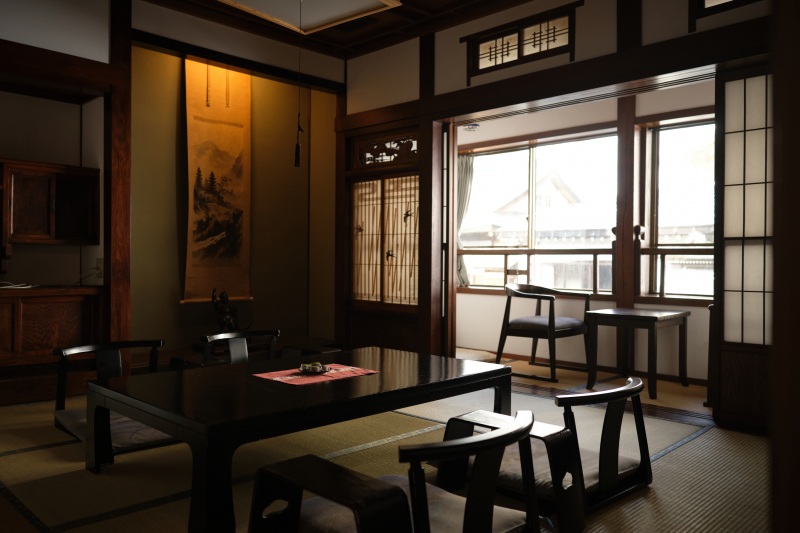
The inn offers a variety of hot spring baths, such as an outdoor hot spring with a scenic view on a plateau, reached by climbing up the stairs adjoining the inn, and private cave baths located underground. The ground floor houses a café for inn guests to enjoy a tea break. At the same time, the wooden interiors will soothe your senses as you enjoy the scenery, leaving nothing to be desired. Once the warm and friendly service rejuvenates your body and soul, take a stroll in town donning a yukata and geta sandals (traditional Japanese summer attire) for an experience not to be missed.
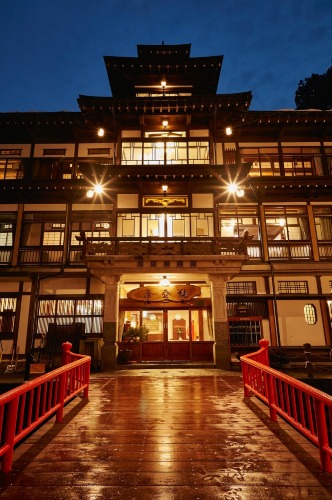
The façade reflects Taisho-era architecture and is reminiscent of the bathhouse depicted in Miyazaki Hayao's blockbuster film "Spirited Away," making it an immensely popular photo spot. The best time to take a photo here is during the sunset when they start to light the lamps. Remember to include the iconic red bridge in front of the building for a photo that looks like it came straight out of the animated film.
Notoya Ryokan
446 Ginzan Shinhata, Oaza, Obanazawa-shi, Yamagata
https://www.notoyaryokan.com/
2. Expert explains therapeutic benefits of Ginzan Onsen
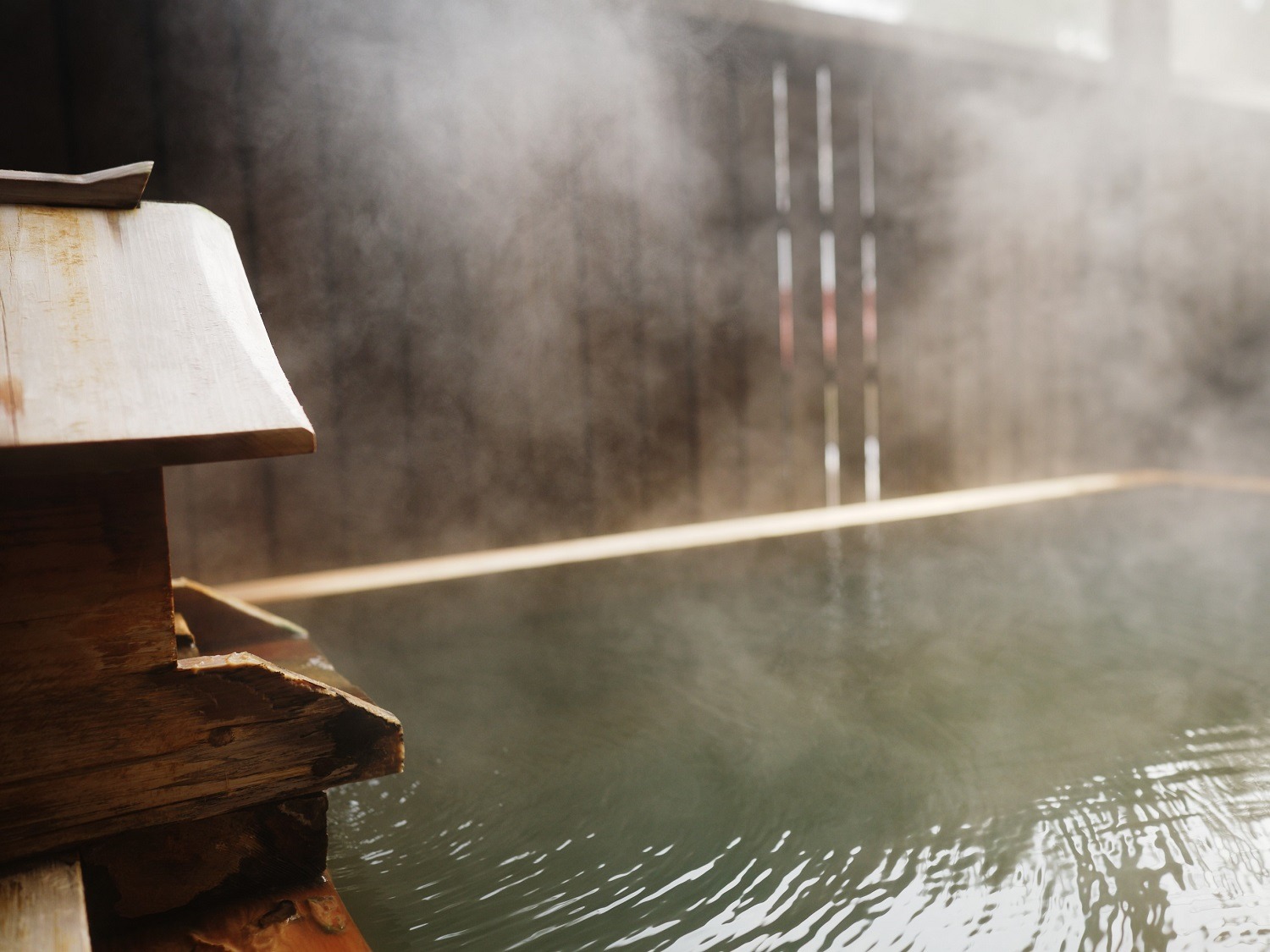 Notoya Ryokan
Notoya Ryokan
If you're staying at Ginzan Onsen, it's a good idea to know about the properties of the hot spring there. We asked Doctor Shinya Hayasaka (Professor & Head of the Department of Human Sciences, Tokyo City University/Ph.D.), who studies the health benefits of hot baths and hot springs from a medical standpoint, about the mineral properties of Ginzan Onsen and the health benefits of soaking in hot springs.
The Japanese people love hot springs, but what exactly are the benefits of soaking in them?
"The number one benefit of soaking in a hot bath is improved blood circulation due to a rise in body temperature. Blood transports oxygen and nutrients to body cells and collects waste for removal; thus, enhancing its circulation reduces fatigue and rejuvenates the body. Additionally, warming the body will suppress nerve hypersensitivity, relieve joint pains in the waist and knees, and loosen tight muscles. Moreover, floating in water can relieve stress and help us sleep better. As you can see, hot baths have many benefits, and hot springs add extra perks on top of that."
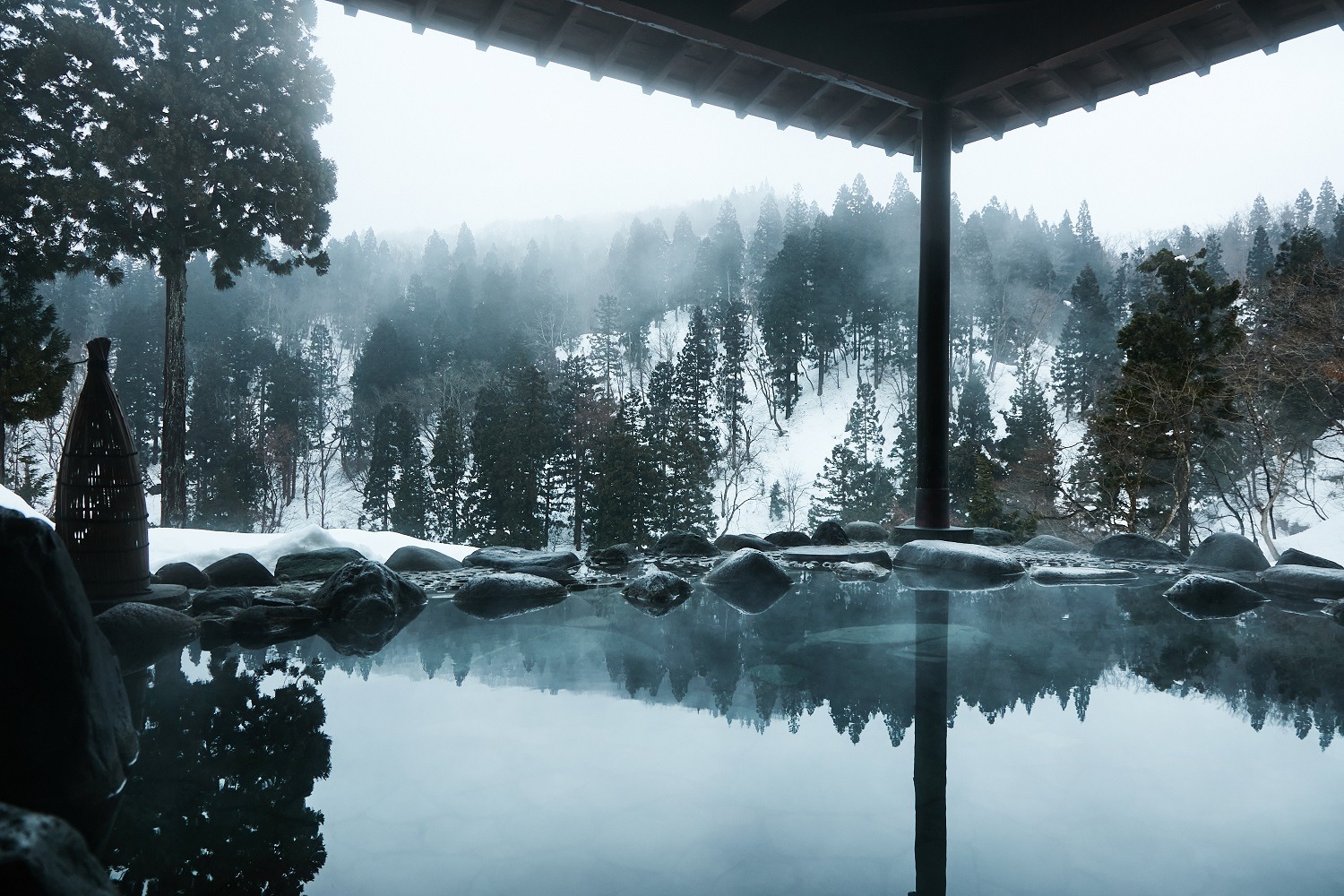 Takimi-kan
Takimi-kan
"Hot springs contain various minerals which supercharge the hyperthermic effect of a hot bath. The biggest difference between a hot bath at home and soaking in a hot spring is 'climatotherapy.' In addition to the hot spring's inherent health benefits, it is believed that being in a different location and enjoying beautiful natural landscapes or quaint townscapes is beneficial for both physical and mental health. According to the 'Nationwide Spa Therapy Benefits Survey Project' (Study Period: 2018–2021) conducted by the Ministry of Environment, which surveyed 11,830 men and women, more than 98% of hot spring visitors said they feel 'rejuvenated' or 'refreshed.' It is clear that a visit to a hot spring resort, even for a short day trip or two days, one night stay has positive effects on both the body and mind."
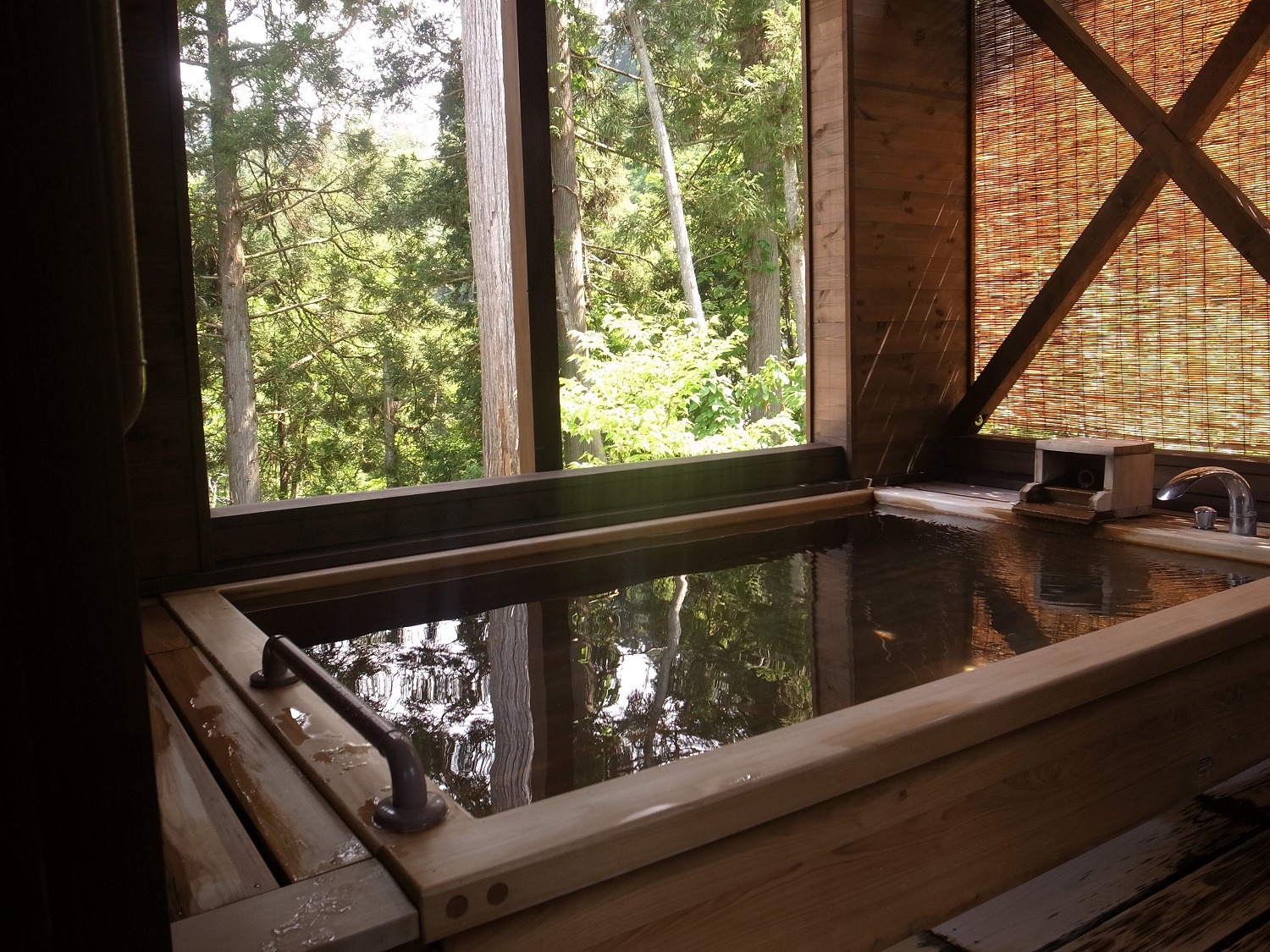 Notoya Ryokan
Notoya Ryokan
"If we take a closer look at the mineral contents of the Ginzan hot spring, the biggest distinction is that it is better at heating the body. The salt minerals in the water coats the skin, preventing the evaporation of water molecules which unnecessarily cools the body during a hot bath. Therefore, your body will feel warm and toasty long after your bath. Furthermore, it contains less hydrogen sulfide—which gives hot springs their distinct sulfuric smell—and the smell is barely noticeable. Too much hydrogen sulfide in the hot spring can damage the skin, so the Ginzan hot spring is relatively gentle on the skin. They also contain plenty of metasilicic acids, a chemical that hydrates the skin, leaving it moist and supple at the end of a soak. It also has calcium ions that keeps the skin smooth and silky even during summer. To summarize, the Ginzan hot spring thoroughly warms the body, is gentle on the skin, and can even improve skin condition."
Other than Ginzan Onsen in Yamagata, the Tohoku region is dotted with hot spring resorts that are unique in their way, allowing you to choose according to your needs.
"The Tohoku region has always been renowned for hydrotherapy, where patrons stay for extended periods at hot spring resorts to rejuvenate, which has helped many resorts prosper as therapy retreats. For spa therapy, you can choose Tamagawa Onsen in Akita or Sukayu Onsen in Aomori. You may also check out Takayu Onsen in Fukushima or Hijiori Onsen for the therapeutic ambiance. For a wide variety of health benefits and spa-hopping, the Naruko Onsen-kyo Village in Miyagi and the Nyuto Onsen-kyo in Akita are highly recommended."
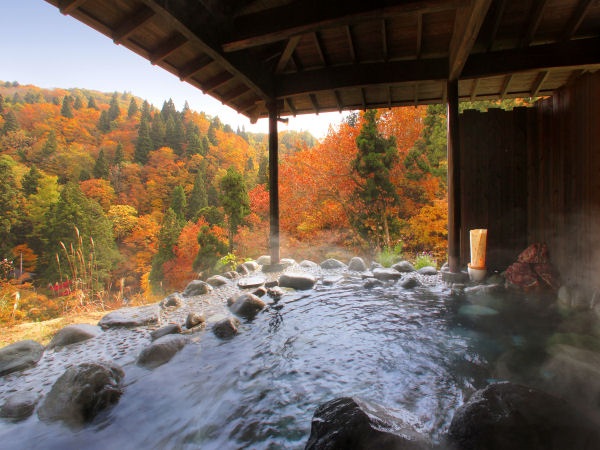
To savor the panoramic view of Ginzan's seasonal sceneries while soaking in a hot spring at a high elevation, head to "Takimi-kan," an inn located on a high plateau that can be reached by going uphill from the hot spring district. From this prime location, you will have a magnificent view of the "Shirogane Falls," a truly liberating experience. Soaking in the outdoor bath will make you feel connected with Mother Nature. Day trip tickets are available, so you can still relish the hot spring bath and the breathtaking views even if you are not staying overnight at the inn. Takimi-kan also serves delicious soba noodles handmade using Obanazawa buckwheat at their soba restaurant, Takimi-tei. Here, you can enjoy soba noodles for lunch, a great combo with a hot bath.
Takimi-kan
522 Ginzan Shinhata, Obanazawa-shi, Yamagata
https://www.takimikan.jp/
3. Highly recommended inn
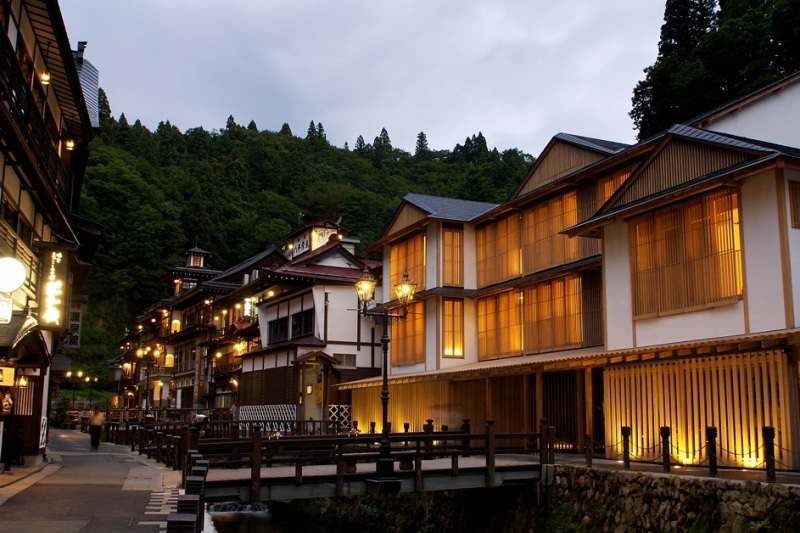
"Fujiya" sports a stylish and stunning façade designed by Kengo Kuma, one of Japan's most distinguished architects. The building was built in the Taisho era and renovated in 2006 with the redesigned facade, which is modern but elegantly blends in with the rest of the townscape with sophisticated wooden architectural elements.
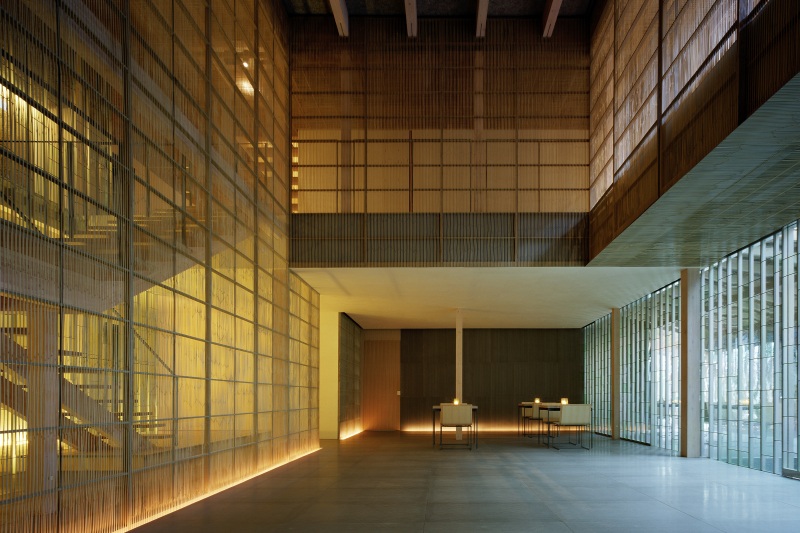
The interior is uniquely decorated with thin bamboo screens called "sumushiko," light green stained glass, and more, stimulating the senses with a unique design concept where time and space "overlap." All guest rooms face the Ginzan River, enabling guests to enjoy the fantastic hot spring townscape. The inn serves carefully crafted Japanese multi-course kaiseki cuisine that are a feast for the eyes and taste buds. All five of their hot spring baths can be reserved for private usage, making this inn the perfect choice if you prefer a luxurious stay.
Fujiya
443 Ginzan Shinhata, Obanazawa-shi, Yamagata
https://www.fujiya-ginzan.com/
Good food is another thing to look forward to during hot spring trips. Most of the hot spring inns at Ginzan serve kaiseki cuisine, mainly prepared using local ingredients. Kaiseki refers to traditional Japanese multi-course cuisine comprising appetizers, soup, grilled items, desserts, and more, with each dish served one at a time. The various local and seasonal delicacies, such as the branded Obanazawa Beef that features good quality fats thanks to the wide temperature range of the climate, seasonal fish and wild plants, and the famous Obanazawa soba noodles, prepared differently at each inn, are truly mouthwatering.
4. Yamagata local wines best enjoyed alongside a hot spring bath
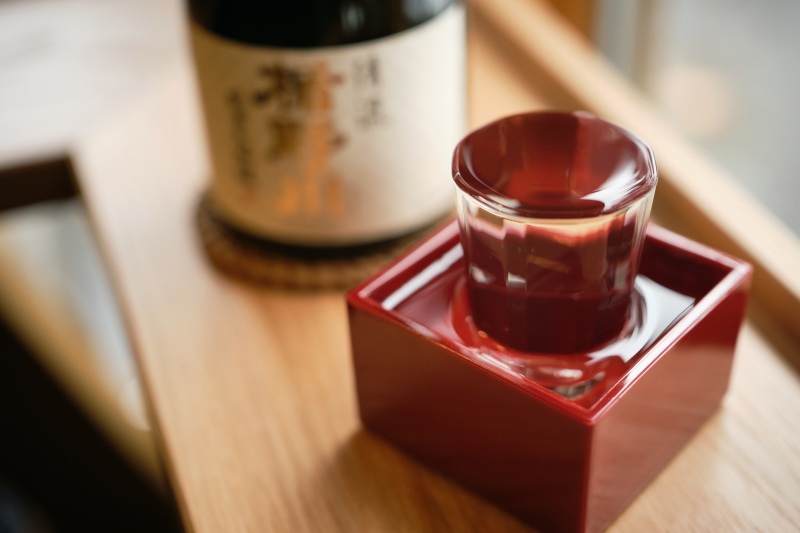
A trip to a hot spring district would not be complete without savoring the local rice wine or sake. With plenty of snowmelt water and high-quality rice, Yamagata prefecture is blessed with the prerequisites for making sake and is home to numerous famous sake. We asked "Yagihashi Shoten," a liquor store in Ginzan Onsen with a vast stock of local sake from Yamagata, about the appeal of Yamagata's sake and the best ways to savor them.
What sets Yamagata's local sake apart is their "high quality and well-balanced taste that appeals to all ages. There is a wide spectrum of flavor profiles, from sake that pairs well with food to sake perfect for enjoying on their own," explains Yagihashi's representative. In Tohoku, Yamagata is one of the biggest international exporters of sake, with brands like "Dewazakura" being well-known even outside Japan.
Choosing the right drinkware is vital to get the most out of your sake-drinking experience. "It is best to use a ceramic sake cup for a sake with rich flavors while a dry, light, and refreshing sake calls for a glass cup." Regarding food pairings, the representative recommended, "Classic sake goes well with protein-rich food such as beans and tofu. On the other hand, avant-garde sake with fruity tastes like wine is perfect to have with oily tidbits with a mild taste, such as cheese and whitefish."
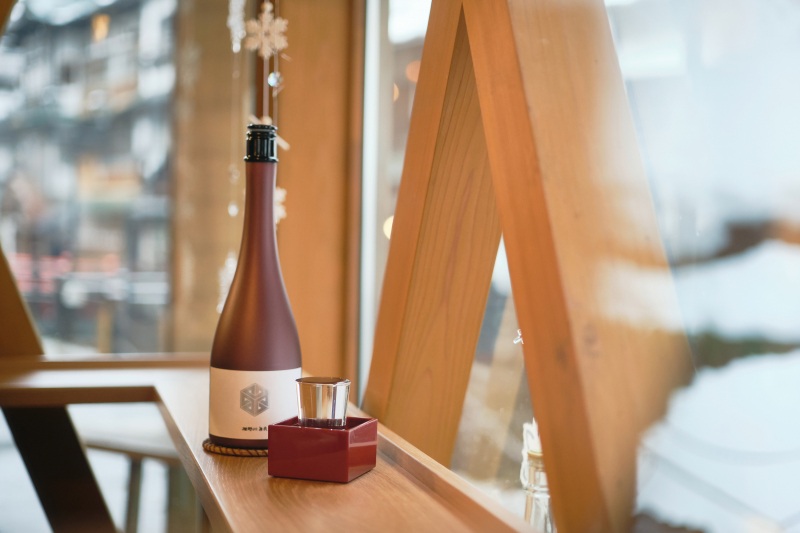
The store has a bar counter where you can try different brands of sake (from ¥500) before buying a bottle. We recommend trying the "Yamakawa Mitsuo" and "Tatenokawa" at the store. The sparkling sake "Hitotoki" is low on alcohol, which is perfect for those new to Japanese rice wine. It also comes in mini bottles that are great for souvenirs. Watch the river flow while sipping an exquisite sake, an experience unique to a destination like this.
Yagihashi Shoten
448 Ginzan Shinhata, Obanazawa-shi, Yamagata
http://yagihashi-jizake.jp/
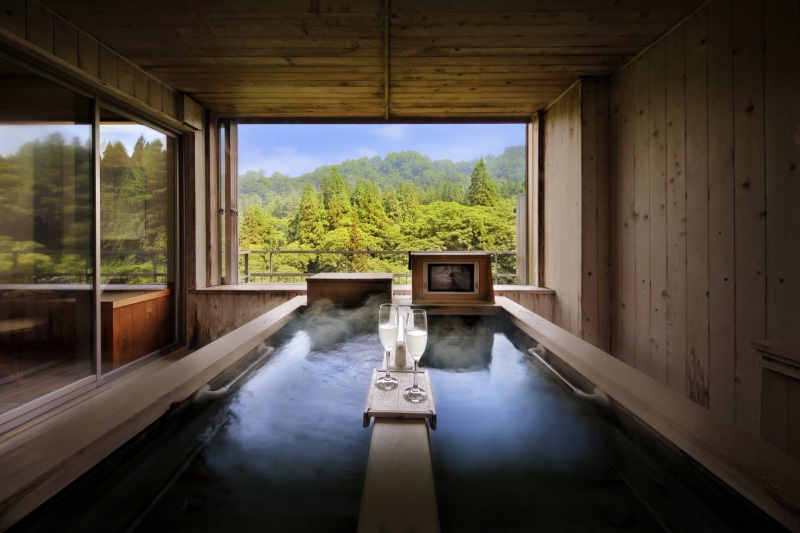
Imagine having a cup of the finest sake while leisurely soaking in a hot spring. Stay in Ginzanso's room with a semi-outdoor lie-down bath to make that blissful dream come true. Enjoy the magnificent panoramic view from the large window while relaxing without worrying about bothering other guests in your private semi-outdoor bath. On top of the alluring night views when the town is lit up, you can also order sake from their extensive menu from the comfort of your room. Feast on the large selection of sake from Yamagata's local breweries like Rokkasen, Dewazakura, and Koya Shuzo, among others.
Ginzanso
85 Ginzan Shinhata, Oaza, Obanazawa-shi, Yamagata
https://www.ginzanso.jp/
The scenery at Ginzan Onsen is different every season. Exploring the hiking trail connected to the hot spring district on foot is highly recommended when it's not covered in thick snow. It starts from the impressive 22-meter "Shirogane Falls" and offers a refreshing stroll through the verdant forests, where you can bask in the green nature during spring and summer and admire the forest canopies aflame with brilliant colors in autumn.
Most of the inns at this resort are small, with 15 rooms or less. The main road across the river is closed to unauthorized cars, so at night, only visitors staying at inns are left at the resort, making it feel like a hidden gem beyond the beaten path. While it is possible to make a day trip here, staying overnight is best if you want to enjoy the resort to the fullest. Take a break from your hectic life and allow yourself some time to relax and unwind. Experiencing the heartfelt hospitality of the hot spring resort residents will undoubtedly heal your mind and body, making it one of your best trips ever.